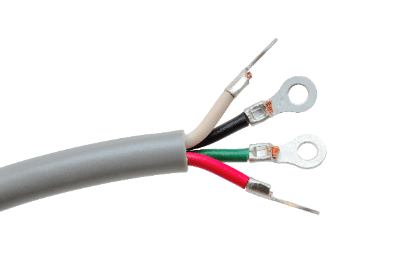What Is a Solderless Terminal?
 A solderless terminal is a type of terminal material used at the end of an electric wire. Solderless terminal is a method of mechanically joining a wire to a terminal by plastic deformation using a tool or other means.
A solderless terminal is a type of terminal material used at the end of an electric wire. Solderless terminal is a method of mechanically joining a wire to a terminal by plastic deformation using a tool or other means.
There are various sizes of solderless terminals depending on the thickness of the wire to be joined and the screw diameter of the terminal block. There are also various methods of connection to the terminal block, such as screw-fastening and screw-in.
When connecting to a terminal block by screwing, there are various shapes of solderless terminals to choose from: Y-type terminals and C-type terminals are easy to work with, but there is a risk of disconnection if they are not tightened properly, so care must be taken.
Uses of Solderless Terminals
Solderless terminals are used to connect terminal blocks and wires firmly.
In general homes, they are used for terminals for wiring between outdoor units and indoor units of air conditioners. They are not visible to the naked eye because they are used by contractors for finishing work.
In industrial applications, it is used in a wide range of applications, from communication wiring to power cables. They are mainly used for terminals when cables are used.
Incomplete crimping can occur due to the use of the wrong tool or work errors. Care must be taken because incomplete crimping can increase the contact resistance of the wire, which can lead to fire or other problems.
Principle of Solderless Terminals
The fixing principle of the solderless terminal is plastic deformation of the wire terminal and the crimp terminal. Once processed, the crimp cannot be undone, and in the event of failure, the wire terminal will be cut.
Solderless terminals have two parts: the barrel and the terminal. The barrel is the part that is connected to the wiring and is large enough to accommodate all the specified wiring core wires. Both the solderless terminal and the wiring are made of a flexible metal material such as copper. They are firmly connected by matching and crushing them together with a crimping tool.
The terminal portion is the part used to connect to the control panel or control equipment. They are available in round, Y-shaped, rod-shaped, and other shapes, and are selected according to the connection destination.
Crimping wire joints has a lower risk of detachment compared to joints using insulation tape or other means.
Types of Solderless Terminals
Solderless terminals are classified into two major types: insulated crimp terminals and bare crimp terminals.
Insulated solderless terminals are crimp terminals with the barrel portion covered with an insulator. Since the insulation is already attached, there is no need for insulation treatment and bending of the connection end can be prevented.
A bare solderless terminal refers to a terminal without insulation in the barrel portion. The barrel portion after crimping is covered with an insulating cap or marked tube for insulation treatment.
There are various types of solderless terminals, including the commonly used round type, the C- or Y-shaped type, and the Y-shaped type with a claw.
Other Information on Solderless Terminals
1. How to Select the Size of Solderless Terminal
The size of the solderless terminal is selected based on the cross-sectional area of the applicable wire and the size of the hole. The engraving on the solderless terminal indicates the shape (round, Y-shaped, etc.), cross-sectional area of the applicable wire, and nominal diameter of the screw portion (e.g., for a round shape with an applicable wire of 5.5 mm2 and a nominal diameter of the screw portion, the engraving is R5.5-6).
Solderless terminals come in a variety of sizes, and if the size of the wire used and the nominal diameter of the screw do not match, a poor connection will result. Since a poor connection can cause a fire, it is important to select the appropriate solderless terminal after checking the specifications.
2. Tools to Be Used With Solderless Terminals
Crimping pliers are used to crimp solderless terminals and connect wires.
Crimping pliers are tools that use the principle of leverage to crush the barrel portion. They are generally equipped with a ratchet function to prevent incomplete crimping.
Crimping pliers are used to crimp different objects depending on the color of the handle of the pliers. The color of the handle determines the application, and crimping pliers with red handles is used for a solderless terminal. Use the appropriate die (the grooved part of the crimp) for the barrel portion of the crimp.